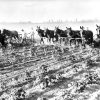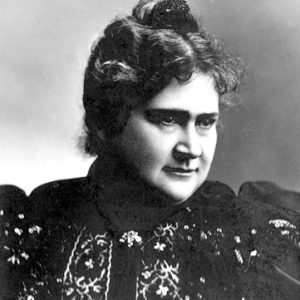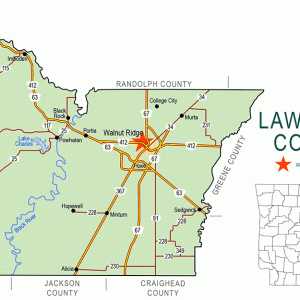calsfoundation@cals.org
Clover Bend Historic District
aka: Clover Bend (Lawrence County)
The Clover Bend community in southeast Lawrence County was the site of a successful attempt to combat the socioeconomic problems of the Great Depression era during the first and second administrations of President Franklin D. Roosevelt. Although it was never incorporated as a town or city, Clover Bend is the oldest settlement in Lawrence County and served briefly as the county seat during Reconstruction.
Pierre Le Mieux and other settlers from France first began farming along the Black River early in the nineteenth century. When steamboat traffic began along the river in the 1820s, the area was made a regular landing. At this time, the many curves in the river at this location gave the landing and community the name Clover Bend. In 1840, Samuel Robinson purchased most of the land in the Clover Bend area from the federal government and began a cotton plantation. Even after the Civil War, Robinson and his manager, Frank Tucker, employed a large force of African Americans as tenant farmers to run the plantation. During Reconstruction, Robinson managed to have the county seat moved to the plantation at Clover Bend, but it was moved to Powhatan a year later.
Robinson died in 1870, leaving the plantation to his son-in-law and daughter, J. Henry and Martha Dowell. Dowell retained Frank W. Tucker to manage the estate; through careful investment of his income, Tucker was able to purchase shares in the plantation, serving as part-owner as well as manager. Dowell lost his share of the estate in a card game to Ernest Allen around 1883. Allen visited the plantation that year with his widowed sister, June Allen Crawford, and with Crawford’s friend Alice French, known chiefly by her pen name of Octave Thanet. French and Crawford built a three-story, fifteen-room house on the property in 1896, which they called Thanford, a combination of their last names; French used first a cabin and later this large house to spend winters in from 1883 through 1909. She did much of her writing there and often wrote about the Clover Bend area.
Tucker remained active in politics, representing the Republican Party a heavily Democratic area. He served at times as chairman of the state Republican Party and was a friend of President Theodore Roosevelt. In 1918, Tucker retired from managing the plantation and moved to Little Rock (Pulaski County), hiring the Slayden brothers to manage the estate. In 1936, financially crippled by the Depression, Tucker sold the Clover Bend plantation to the Slayden brothers; the next year, they sold the land to the federal government.
The 5,600 acres were purchased as part of a New Deal program meant to bolster the nation’s struggling agriculture by supporting small privately owned farms. Originally administered by the Resettlement Administration and later by the Farm Security Administration (FSA), the Clover Bend project has been cited as the first major alternative to the established farming practices to be offered to the area’s tenant farmers in generations. It was geared to break the cycle of borrowing against earnings on one crop to plant a new one. The Clover Bend settlement was one of ninety-nine such experiments across the United States, including half a dozen others in Arkansas.
The plantation was divided into eighty-eight units averaging forty-five acres each, though some were as large as sixty-five acres. Farmers received the land, a four- or five-room house, a barn, a poultry house, and other outbuildings. They paid $200 a year on a forty-year mortgage, but the leases were designed to allow the government to end the contract after five years if the farmers were unsuccessful. Crop diversification was emphasized in the program, as farms raised cotton, clover for hay, sweet potatoes and other vegetables, dairy and beef cattle, hogs, and poultry.
In all the FSA programs, participants were chosen by a county agricultural board, with approval from district and state boards and a federal board of oversight. Generally, the choices of the county board were approved at all levels. County boards often granted preference to prior landowners rather than to tenant farmers, but this pattern was not followed at Clover Bend. In fact, the success of the Clover Bend project has been attributed to the fact that most of the families involved had always lived in the area and were acquainted with the land. Clover Bend was called the FSA’s most successful project in Arkansas, an outstanding example of a successful public works project to aid impoverished rural Americans.
Clover Bend High School became the social center of this ambitious project. The Clover Bend schools were a result of the consolidation of other area schools, bringing in students from Arbor Grove, Minturn, Counts, and Coffman. The elementary school opened in January 1938, and the high school first held classes in the fall of 1939, graduating its first three students in May 1940. The school existed until 1983, averaging about 350 students a year in grades kindergarten through twelve.
World War II marked an end to many New Deal programs as the government’s attention turned to the war effort. The school and the land on which it stood were given to the school district in June 1945; farmers continued to pay their mortgages and farm their land. As the years went by, many of the small parcels of land were sold and larger farms began to emerge once again.
When consolidation closed the Clover Bend school district in 1983, the Clover Bend Historic Preservation Association was formed to preserve the history of the area. The Clover Bend Historic District, comprising five buildings from the Clover Bend High School (a main building, a gymnasium, a cafeteria, a cottage devoted to vocational home economics, and a vocational agriculture building) was listed in the National Register of Historic Places on September 17, 1990. Five additional buildings (a farm house, a barn, a chicken house, a smokehouse, and an outdoor bathroom) were moved onto the thirteen-acre site to recreate the FSA appearance. Approximately 3,000 people visit the Clover Bend Historic District each year. The Clover Bend Reunion is held annually on Memorial Day weekend.
For additional information:
Cobb, Kellie. “Clover Bend: Preserving the Past.” Jonesboro Sun. December 30, 2007, pp. 1C, 10C.
Covey, Reta Goff. “History of Clover Bend.” Lawrence County Historical Quarterly 2 (Summer 1979): 5–16.
Lawrence County, Arkansas 1815—2001. Paducah, KY: Turner Publishing Company, 2001.
Whayne, Jeannie M. A New Plantation South: Land, Labor, and Federal Favor in Twentieth-Century Arkansas. Charlottesville: University Press of Virginia, 1996.
Bill Norman
Little Rock, Arkansas
Staff of the Encyclopedia of Arkansas History & Culture
 Farm Resettlement Projects
Farm Resettlement Projects Clover Bend Historic District
Clover Bend Historic District  Alice French
Alice French  Lawrence County Map
Lawrence County Map 




The original school wasn’t too far from the school that’s there now. It was just down a little ways on the same road as Wood’s Store. I do like seeing pictures of the school again. Clover Bend means a great deal to me. I lived there my whole life.